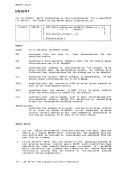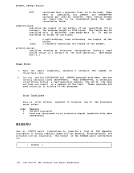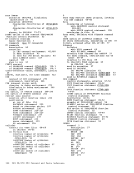LINEDIT Macro results in the display of the first nine bytes at the address in
register 6, in the format:
hhhhhhhh hhhhhhhh hhCHARA,address substitutes the character data at the specified address into the
message text. For example:
LINEDITTEXT='NAME IS •• •••••••••• '··,SUB=(CHAR1,NAME) causes the 10 characters at location NAME to be substituted into
the message text.Kultiple blanks are removed.
CHARA, (reg)
substitutes the character data at the address indicated in the
specified register into the message text. For example:
LINEDITTEXT=' CODE IS •••• ', SUB= (CHARA, (7) ) the first four characters at the address indicated in register 7
are substituted in the message line.
CHAR8A,address
substitutes the character data at the specified address into the
message text, and inserts a blank character following each eight
characters of output.When vou code the message text, you must code enough periods to
allow for the blanks that will be substituted.
This substitution list is convenient for displayingeMS parameter
lists. For example, to display a fileid in an FSCB, you might code
LINEDITTEXT='FILEID IS •••••••••••••••••••• ', SUB=(CHAR8A,OUTFILE+8) where OUTFILE is the label on an FSCB this file were TEST OUTPUT Al, then the
would result in the display:
macro. If the fileid for
LINEDIT macro instruction
FILEIDIS TEST OUTPUT A1.
In the final editedsingle blank.
substitutes the character data at the address indicated in
specified register and inserts a blank character following
eight characters of output.
the
eachWhen vou code the message text, you must include sufficient periods
to allow for the blanks. For example:
LINEDITTEXT=IPLIST: ••••••••••••••••••••••••••••••••••• , SUB= (CHARS!, (1) )
results in a display of four doublewords of character data,
beginning at the address indicated in register 7.
Section 6.CMS Macro Instructions 325
register 6, in the format:
hhhhhhhh hhhhhhhh hh
message text. For example:
LINEDIT
the message text.
CHARA, (reg)
substitutes the character data at the address indicated in the
specified register into the message text. For example:
LINEDIT
are substituted in the message line.
CHAR8A,address
substitutes the character data at the specified address into the
message text, and inserts a blank character following each eight
characters of output.
allow for the blanks that will be substituted.
This substitution list is convenient for displaying
lists. For example, to display a fileid in an FSCB, you might code
LINEDIT
would result in the display:
macro. If the fileid for
LINEDIT macro instruction
FILEID
In the final edited
substitutes the character data at the address indicated in
specified register and inserts a blank character following
eight characters of output.
the
each
to allow for the blanks. For example:
LINEDIT
results in a display of four doublewords of character data,
beginning at the address indicated in register 7.
Section 6.






















































































































































































































































































































































































































